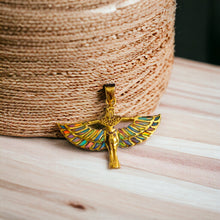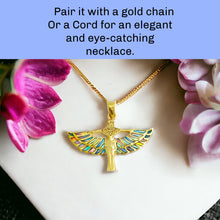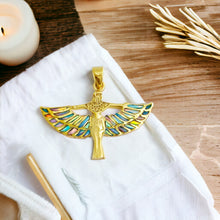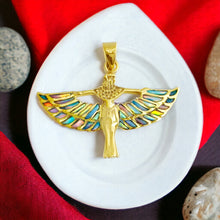Winged Opal Goddess isis Gold Pendant Necklace
- Regular price
- $75.00 USD
- Sale price
- $75.00 USD
- Regular price
-
- Unit price
- /per
Sale
Sold out
Shipping calculated at checkout.
Adding product to your cart
The Winged Opal Goddess Isis Gold Pendant Necklace combines ancient symbolism with modern elegance. Crafted with opal and gold, this necklace pays homage to the Egyptian goddess Isis, symbolizing femininity, power, and protection. Discover the history behind this timeless piece.
- The color of opal jewelry changes depending on the angle of its light reflection. When the opal is rotated, the color dances with a rainbow magic sparkle throughout the stone.
-
Certainly! Here's an optimized set of bullet points for the Winged Opal Goddess Isis Gold Pendant Necklace:- **History**: Inspired by the ancient Egyptian goddess Isis, symbolizing femininity, magic, and motherhood.- **Spirituality**: Revered for its connection to spiritual energy and divine femininity, offering protection and guidance.- **Talisman**: Serves as a talisman for spiritual seekers, enhancing intuition and promoting inner healing.- **Handmade**: Crafted with meticulous care and attention to detail, each pendant is unique and carries a personal touch.- **Healing**: Believed to possess healing properties, promoting emotional well-being and spiritual growth.- **Material**: Made from high-quality gold, symbolizing wealth, purity, and divine radiance.- **Symbolism**: The wings represent freedom and ascension, while the opal signifies creativity and emotional balance.- **How to Wear**: Easily fits any chain up to 5mm (0.2 inches) in thickness, allowing for versatile styling and personalization.- **Ideal Gift**: Perfect for loved ones seeking spiritual connection or those drawn to Egyptian mythology and symbolism.
History Side For Those Who Are Interested
The Egyptian goddess Isis is one of the most significant figures in ancient Egyptian mythology. Her origins date back to the earliest periods of Egyptian civilization, with evidence of her worship dating as far back as the Old Kingdom (circa 2686–2181 BCE).
Isis was primarily known as a goddess of magic, motherhood, healing, and protection. She was often depicted as a woman wearing a throne-shaped headdress, symbolizing her role as the queen of the gods and the protector of the throne of Egypt. In some depictions, she is shown with wings, representing her ability to fly and traverse the realms of the living and the dead.
According to Egyptian mythology, Isis was the sister and wife of Osiris, the god of the afterlife and the underworld. Together, they ruled over the living and the dead, ensuring order and harmony in the universe. However, their reign was disrupted when Osiris was murdered by his jealous brother Set, the god of chaos and disorder. Isis mourned the death of her husband and embarked on a quest to resurrect him.
Through her magical abilities and determination, Isis succeeded in resurrecting Osiris, albeit temporarily. Together, they conceived a child, Horus, who would later become a powerful god associated with kingship and the protection of Egypt.
Isis was revered by ancient Egyptians as a compassionate and benevolent goddess who provided guidance, protection, and healing to those in need. Her cult grew in popularity throughout Egypt and beyond, with temples dedicated to her worship found throughout the ancient world.
As Egyptian civilization evolved, Isis became increasingly syncretized with other goddesses, particularly with the Greek goddesses Demeter and Aphrodite, as well as with the Roman goddesses Venus and Fortuna. This syncretism contributed to the spread of her worship beyond Egypt and ensured her continued significance in the religious practices of the Greco-Roman world.
Despite the decline of ancient Egyptian religion with the rise of Christianity and the eventual spread of Islam in Egypt, the legacy of Isis endured through the ages. Her symbolism and mythology continued to influence various cultures and religions, leaving a lasting impact on art, literature, and spirituality worldwide. Today, she remains an iconic figure in the study of ancient Egyptian religion and mythology, revered for her wisdom, compassion, and magical prowess.
Use left/right arrows to navigate the slideshow or swipe left/right if using a mobile device




























